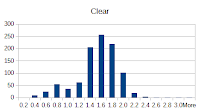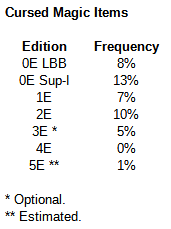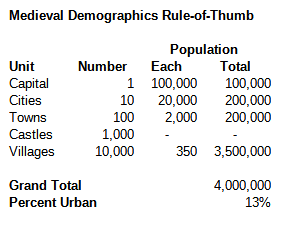 A week back on the Wandering DMs YouTube channel we had a nifty conversation on the status of Cursed Magic Items in D&D. Largely we came out in agreement that they're a nice spice that makes magic in general feel more mysterious and dangerous. In the after-party chat on Discord, one of our Patrons asked: What exactly was the frequency of cursed magic items in the early editions? Did it really change very much over time?
A week back on the Wandering DMs YouTube channel we had a nifty conversation on the status of Cursed Magic Items in D&D. Largely we came out in agreement that they're a nice spice that makes magic in general feel more mysterious and dangerous. In the after-party chat on Discord, one of our Patrons asked: What exactly was the frequency of cursed magic items in the early editions? Did it really change very much over time?
Which I thought was a very good question, and I started researching it. And looked at every single magic item in D&D. In every single edition over the years. (Core rules only, thank you.) I guess it's my curse, but I hope it benefits you, Gentle Reader.
Original D&D (LBBs)
Here we're looking solely at the Little Brown Books in the white box, specifically Vol-2, which has both the monsters and treasures (including magic items). As noted in the WDMs show, pre-3E, there's no "keyword" system, so in most cases it's hazy about whether an item should count as "cursed" or not. However, the need for a remove curse spell to get rid of it is a pretty good sign, among others (more on that issue later). I'm sure there will be one or two items you'd differ with me in adding
or taking out of these lists, but it won't change the overall numbers
significantly.
In this case, I can only count six (6) items as cursed -- the sword –2, potion of delusion, potion of poison, cursed scrolls, ring of weakness, and ring of delusion.
Notice there are no cursed armors, non-sword weapons, wands/staves, or miscellaneous magic. Some of those will soon be added -- but there are no cursed wands/staves in any edition. The overall chance of cursed items turning up here is 8%.
Original D&D (Greyhawk Supplement)
Less than a year later, Gygax published D&D Supplement I, Greyhawk. It includes extensive "Additions and Changes" to the magic item tables; although the master types table, and the scrolls table, are unchanged and do not appear in this story (that latter being something I almost overlooked in computing statistics here).
Several new cursed items are added, seemingly in an attempt to cover almost any form-factor of magic item in the game, including: one sword, one other weapon, an armor, a shield, one ring -- and thirty-three (33) miscellaneous magic items. I won't list them all here, but suffice to say pretty much any form of miscellaneous magic in the LBBs now has a cursed analog in the world by which to trick players. I think the majority of new magic items in the book are these cursed iterations of pre-existing magic items. Previously no miscellaneous magic was cursed; now 30% of the time miscellaneous items are cursed.
And there's another issue that I'm not counting here, in an expansion of item types that are keyed to some class or alignment, helping the associated, but likely blasting others who pick it up. There's a special paragraph note (p. 59) that all manuals, books, librams, and tomes curse a reader who fails to benefit from it to hide and guard the book against anyone else successfully using it. (Dealing with the expansion of alignment-based effects would be an entire article unto itself.)
That said, the master table only sends you to miscellaneous types 5% of the time, so in the overall results this makes a very small difference, adding about 1.5% frequency (we've actually noted this both of the last two weeks in our WDMs chats on YouTube). But other stuff also adds to the chances: the new cursed armor & shield adds 2% to the cursed chance, and the chances for cursed rings expands to 1.5%. In total for this supplement, the chance of a cursed item now stands at nearly 13% (12.58%). This moment represents the high-water mark for cursed items in the game, and what we'll see in later editions is a slow erosion of the overall concept (including very few new cursed items added to the game after this point).
AD&D 1st Edition
The AD&D Dungeon Masters Guide is very helpful for this study, because the tables effectively flag bad/cursed items -- by virtue of leaving the XP and/or GP column blank in those cases. For instances in other editions (both before and immediately after) where I couldn't confidently tell one way or the other, I've used this as an indicator to resolve the issue by designer intent. (With one exception: the jewel of flawlessness is clearly only beneficial, despite having a null XP entry, so I've left it out of my count here. Other stuff with both pro-and-con effects, like artifacts and the deck of many things, I've synchronously counted as cursed, but they're negligible factors in the final numbers either way.)
Here, Gygax has kept all the same cursed types as seen in Sup-I, but seems to have notably dialed down their frequency in most cases of potions, swords, armors, and rings. The cursed miscellaneous magic is about the same (1.65% of the total; about 1% or 2% on each of five sub-tables). The total frequency of cursed items therefore adds up to only 7%, a single percentage point below what it was in the OD&D LBBs.
AD&D 2nd Edition
AD&D 2nd Edition has an interesting change in idiom to the tables for magic weapons; there are separate tables for weapon type, vs. magic effect, the matrix of which can generate many more varieties of magic weapons than what was seen previously. In the table for magic weapon bonus, there is a flat 10% (2-in-20) chance the modifier on any magic weapon is –1, which is a significant increase from earlier rules.
However, there are no general rules or commentary on the status of these negative-modifier weapons that I could find. Is the player stuck with using it permanently until a remove curse can be accessed? Without explicit text on that point, my reading would be no. Likewise, the list of cursed scroll effects is radically reduced in power -- 0E/1E had a list of instant-death, removed from planet effects, etc.; 2E replaces those with a -1 modifier to checks, taking 2-6 points damage, growing a beard, etc.
So while the overall frequency of cursed items in 2E has gone up to 10% (due to the magic weapons table), arguably the impact of those baneful magic items is much reduced.
D&D 3rd Edition
The 3rd Edition DMG makes the whole issue of cursed items optional; if utilized, then any discovered magic item has a flat 5% chance of being cursed (DMG p. 231). This sends the DM to a separate set of tables to find add-on effects modifying the magic item in question -- things like delusion, opposite effect, intermittent functioning, trigger requirements, certain drawbacks, etc. Generally these are fairly gentle side-effects (compare to 2E scrolls above). There is a 10% chance to be sent to the "Specific Cursed Items" table, which has about 30 items carried forward from the AD&D list (mostly miscellaneous magic, as to be expected).
There's also a behind-the-curtains sidebar discussing the pros & cons of having cursed items in the game -- it suggests that items with both benefits & drawbacks make for more interesting tough choices in the game. And that PCs finding that they have a cursed item should be able to get rid of the item easily (a hard about-face from Gygax's O/AD&D).
Some of that philosophy I really like: The benefits + drawbacks dilemma is very much in line with what we agreed to on our WDMs show. I also really like the structure of separate add-on tables for curses, so any such item gives room for creativity and customization by the DM, and likely any cursed item is a unique creation (as opposed to the very large amount of ink spent in OD&D Sup-I providing individual cursed types of every form factor). But the effects here in 3E are generally so weak that I tend to think most of them wouldn't have any interesting impact.
D&D 4th Edition
Many idioms of 4E, including magic items, are so different from any other edition that they're almost incomparable. For example, magic items are such a critical and expected part of character builds, that the whole list appears in the PHB (whereas all other editions have them in the DMG). I'm also told that having them fully, fungibly convertible to cash on demand is a key mechanic.
That said, I can't find any bad/cursed items in the 4E list. There's a power called warlock's curse, and some items boost that to the benefit of the caster/owner. There is an item called curseforged armor, but that's just flavor-text (crafted by bitter halflings), and again, beneficial to the wearer. So as far as I can tell the frequency of cursed items is zero (0%).
D&D 5th Edition
D&D 5E has a very small number of classic cursed items return to the game. By my count, these are: armor of vulnerability, bag of devouring, berserker axe, demon armor, shield of missile attraction, sword of vengeance (the classic cursed sword), and dust of sneezing & choking. That's close to the same number as in the OD&D LBBs. Most of these are tagged explicitly with the "cursed" keyword; the bag of devouring and dust of sneezing & choking are not, but I've counted them anyway (in line with the 1E understanding). There's a very curt 5 sentences on the general status of cursed items (DMG p. 138-139). Some of the effects are notably changed from older editions. Note that 5 of the 6 items are weapons & armor; there is now only one cursed miscellaneous item, that indelible and infamous bag of devouring (contrast sharply with OD&D Sup-I!).
Now, calculating the frequency of appearance here is a tougher problem, because the magic item tables are split up by level of power (into tables A through I), and those are keyed not from a master table, but from the encounter-level tables, which produce different possible packages of treasure. So parties of different levels will be running against different result tables, and hence different chances of cursed items, over the course of their adventuring careers. Tables A, C, E, and I have no cursed items. The others have either 1%, 2%, or in one case 3% frequency of cursed items (just a single cursed item each on tables B, D, F, and H, but three items on table G alone). Let's take a rough average over all the tables and say the frequency is about 1%.
Conclusions
Below is a summary table of the chance for a random magic item to be cursed in any edition of D&D to date. As you can see, the idea in Gygax's mind circa the Greyhawk supplement for magic items to be commonly cursed and dangerous to the players, and appearing in any form-factor that a beneficial item might, washed away with the tides, becoming less frequent, and much less punishing over time. As of the last 3 editions, many campaigns have been run with official support for no such items appearing whatsoever. As a guess, it seems quite likely that they might be totally absent (again) from the core books of whatever the next edition from WOTC might be.
Download a work spreadsheet here with comprehensive listings of every cursed item (ODS format).





































